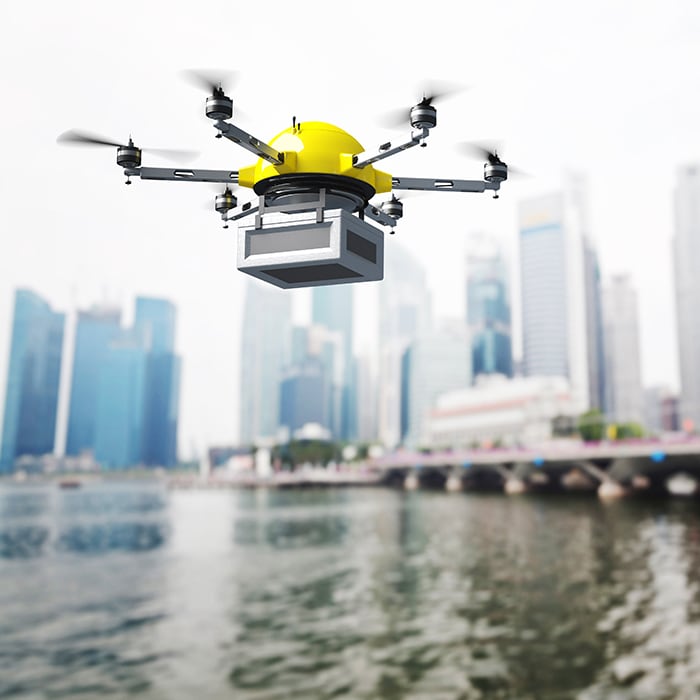Digital disruption to aerospace and defense sustainment has been saved

Perspectives
Digital disruption to aerospace and defense sustainment
Blockchain, automation, and predictive analytics are delivering industry-shaping change
As the aerospace and defense industry enters the fourth industrial revolution, digital disruption is challenging companies to rethink how they create value for customers, compete to capture value for themselves, and transform the way they work.
Explore content
- Seizing the opportunities of digital disruption
- Blockchain
- Automation
- Predictive analytics
- Closing thoughts
Seizing the opportunities of digital disruption
While there are many digital forces at work in the market, three, in particular, have great potential to be both disruptors to existing sustainment norms, as well as great opportunities to deliver industry-shaping change:
- Blockchain
- Automation
- Predictive analytics
Blockchain
What is it?
A distributed digital ledger that improves supply chain visibility, reduces costly paper processing, and offers security against counterfeiting parts.
- Relies on well-established cryptographic principles and operates as a repository for information, which is recorded and shared through a peer-to-peer community.1
- Adoption is sharply increasing, as Gartner Inc. projects a business value-add growth to $176 billion by 2025 and $3.1 trillion by 2030.2
How does it apply to sustainment?
Blockchain solutions can address the traditional sustainment challenges of:
- Securely sharing and tracking part information
- Lack of a central, single “version of the truth”
- Limited standards, and rules for data sharing
- Costly paper-based transaction processing
Why should companies care?
Total worldwide data is forecasted to increase to 16 zettabytes by 2025—that’s 10 times the amount today.3 There is tremendous value in having blockchain serve as a “universal method” that allows everyone to process, record, and track information without having to invest in proprietary systems or technologies. Representative examples of blockchain efficiency gains include:
- Reductions in manual, inefficient labor hours that are currently used to process paper transactions;
- Improved data quality issues due to a central, verifiable source of data; reductions in resources tied to digitizing, archiving and sharing paper forms and documents—one estimate suggests that almost 90 percent of all maintenance records are paper-based, requiring millions of boxes to store the documents;4
- And arguably most importantly, more accurate digital aircraft record keeping, with quicker ownership transfer approval and sign off for leasing.

Automation
What is it?
A way to automate repetitive, rules-based processes by emulating human execution in an effort to either increase operational capacity or improve efficiency or quality.
- Delivered through software that can be rapidly configured to undertake rules-based tasks.
- Examples include opening emails and attachments, to conducting data calculations and analysis.
How does it apply to sustainment?
Numerous applications exist for sustainment, including:
- Tracking items due in for maintenance
- Looking up the source of repair for parts
- Managing inventory and replenishments
- Issuing and managing customer orders
- Providing customer support
- Integrating data & issuing alerts
- Monitoring aircraft status and entry
Why should companies care?
Automation offers sustainment providers the ability to add value to the organization’s operating model, potentially driving higher productivity, increased compliance, and reduced error rates, all at a lower cost. Representative examples of automation value-add include:
- Reduces costs to execute transactional processes by 25-50 percent.5
- Operates 24 hours a day/7 days a week, leading to higher-throughput than manual processing.
- Reduces cycle times and decreases the need for ongoing training—typically, one robot can complete the work of 2-5 full-time equivalents.6
- Improves quality—out of every 100 process steps, humans are likely to make 10 errors—robots perform consistently, accurately, and tirelessly.7

Predictive analytics
What is it?
The use of data, statistical algorithms, and machine-learning techniques to identify the likelihood of future outcomes based on historical data. Predictive analytics models utilize integrated, analytics capabilities to enable a plan/forecast with advanced insight and visibility into the multiple drivers of performance.
How does it apply to sustainment?
- Applicable to the entire industry: Original equipment manufacturers, lessors, operators, and maintenance repair and operations providers
- Use cases include: Planning scheduled maintenance, forecasting part/subsystem failures, and improving aircraft uptime/utilization
Why should companies care?
In an increasingly digital world, drawing insights from aircraft and systems data is a common challenge. Determining what is meaningful requires knowledge of relationships among data that is not readily evident. Predictive analytics offers numerous benefits to enable better data usage for decision making:
- Identification of impending failures or failure conditions, allowing improved scheduling of maintenance, repair, and overhaul (MRO) activities including workforce scheduling, parts positioning, and potentially offering more profitable execution.
- Improved transparency and visibility into forecast accuracy and increased levels of integrity in financial plans by decreasing subjectivity and collection errors.
- Increased aircraft availability by up to 35 percent.8
- Real-time performance analysis–generated performance clarity by identifying the underlying internal and external business drivers.
Increased duration between heavy maintenance intervals due to increased accuracy of failure/service parts identification, in addition to reliability improvements and better repair process planning.

Closing thoughts
While digital solutions might seem like they are in their infancy, the reality is that many in the industry are aggressively pursuing these solutions. We see blockchain, automation, and predictive analytics as clear opportunities to position companies as leaders across the sustainment lifecycle.
Companies that incorporate these digital solutions into their sustainment operations could potentially create new sources of competitive advantage, deliver greater profitability, and increase the likelihood of differentiating themselves.
1 Lory Kehoe and Kai Gindner, “When two chains combine – Supply chain meets blockchain.”
2 John-David Lovelock and David Furlonger, “Three things CIOs need to know about blockchain business value forecast,” Gartner Inc.
3 Nick Ismail, “The value of data: forecast to grow 10-fold by 2025".
4 Paul Seidenman and David Spanovich, “Why Airlines, Aftermarket Struggle With Digital Record-Keeping.”
5 Institute for Robotic Process Automation & Artificial Intelligence.
6 Ibid.
7 Ibid.
8 “Can predictive maintenance become the future of aircraft MRO?”

Recommendations
Blockchain in aerospace and defense
The case for a globally accessible, secure digital parts platform





Latest news from @DeloitteMFG
Sharing insights, events, research, and more